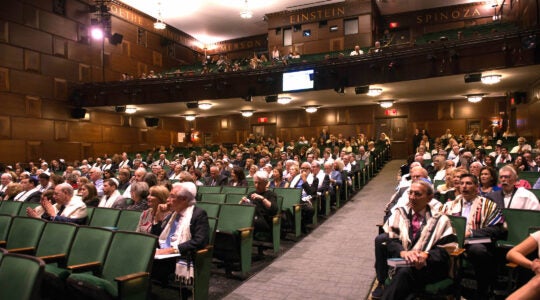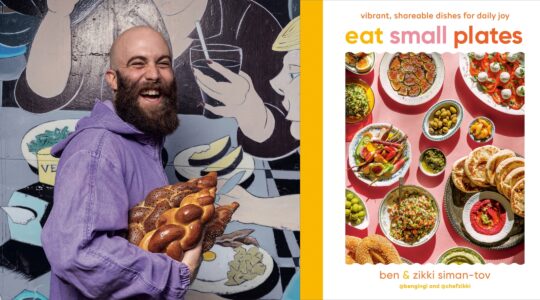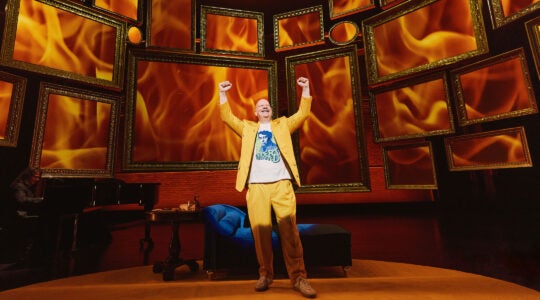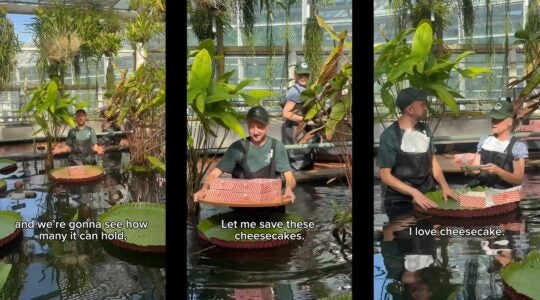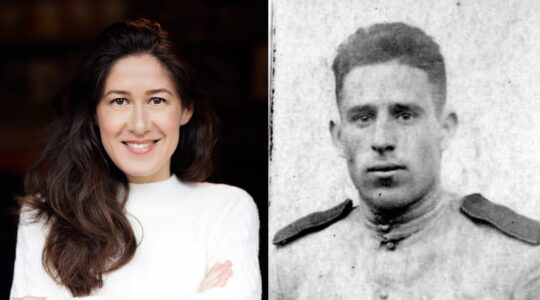Hoping to stir up a little debate on a somewhat taboo topic, art critic Max Kozloff has mounted a historical exhibition of street photography that dares to define a Jewish aesthetic. "New York: Capital of Photography," at The Jewish Museum through September, argues that there’re two kinds of New York photography: Jewish and gentile.
"It’s totally provocative," Kozloff says, chuckling to himself during an interview at the press opening.
"All the gentile photographers assume that democracy is an accomplished fact," Kozloff explains. Jews are less sure of themselves. "Jewish photographers move through territory they can’t quite say they’ve claimed." For them, everyone is displaced in America, or at least in the teeming streets of New York.
Kozloff makes much of his case in the final chapter of the catalogue. Exhibit A is Walker Evans’ 1930 headshot of a stylish woman impassively negotiating the crowds of Times Square. Exhibit B is Lou Stoumen’s 1940 picture of a wistful young man set against the giant marquee of the Strand Theater as a quizzical passerby looks on.
According to Kozloff, the former photograph demonstrates the containment of chaos in discovered structure, while the latter invokes psychic distinctions. In other words, one is goyish, the other Jewish.
Kozloff expects many people to disagree. "It’s a risky thesis. Ethnic aesthetics are not so fashionable these days, particularly as concerns a class of white males." (In fact, many great Jewish photographers are women.)
The Jewish role in photography has only rarely been examined, most notably in George Gilbert’s self-published "The Illustrated Worldwide Who’s Who of Jews in Photography," with 550 biographies from Spinoza (who made lenses) to the inventors of Kodachrome (Leopold Mannes and Leopold Godowsky, Jr.). But the 80-year-old photographer and historian, who quickly sold out of 1,000 copies, lacks the energy to put out a new edition unless he finds a commercial publisher.
The author of several books on photography and a street shooter himself, Kozloff approached The Jewish Museum four years ago to organize this exhibition, his second effort as a curator.
Over two-thirds of the photographers in the show are Jewish, Kozloff says, and if he were to reshuffle the deck and examine a different aspect of photography in New York, like fashion or abstraction, the ratio would be much the same. While Jews are overrepresented in many modern cultural forms in America, they may be most ubiquitous in photography.
"I’m Jewish myself; I knew it had to be talked about. And The Jewish Museum egged me on."
Kozloff’s exhibition wall texts, however, are far more neutral in presenting Jewish aesthetics of New York street photography. The emphasis is on seeing the vastness of the city through its humbling architecture and chic, downtrodden and oddball citizens. The images emanate from high-energy nodes-Coney Island, Times Square and Wall Street.
"Outsiderness wasn’t an impediment, but was the experience," says Kozloff. Jewish street photographers were highly conscious of the dynamic among self, subject and setting. Jews were also the first to document the everyday lives of Harlem and Chinatown.
"There’s no simple answer to any of these questions," says Howard Greenberg, a photography dealer and the largest single lender to the exhibition, with 21 of the show’s 105 photos. He’s eager to read Kozloff’s catalogue, but is skeptical about sweeping generalizations. "You find exceptions galore."
Kozloff intends to make several other points with "New York: Capital of Photography" to articulate his passion for aggressive documentary photography.
"It’s sort of a polemical show to go against the grain of the [art world’s] perceived animosity toward the active witness," Kozloff says. In the past 20 years, he says, art galleries have been enthralled with digitally altered, staged and conceptual photography, like the images of Cindy Sherman.
The emphasis on direct representation of the human figure in "New York: Capital of Photography" serves Kozloff’s thesis well. He begins with classic early 20th century photographs by Karl Struss, Alfred Stieglitz and Paul Strand that record Manhattan as a state of mind rather than a lived experience. But by turning his lens to the human condition, Lewis Hine is the one Kozloff considers to be "the foundation figure of New York photography."
Although Hine was not Jewish, the artists he most greatly influenced were Jews, especially Ben Shahn and those in the Photo League, founded in 1936. This period marked the birth of socially conscious street photography.
The next section of the exhibit focuses on how the Depression pushed the individual to the forefront. Alongside the earnestness, a certain sardonic humor surfaces, first with Margaret Bourke-White’s maddening image of Sergei Eisenstein having a shave on her terrace (1930). In the next few decades, many biting pictures emerged from dark masters Weegee, Diane Arbus, Lisette Model and Garry Winogrand.
But these are all familiar names. Another of Kozloff’s aims is to expand the story of New York photography by showing lesser-known artists, like Saul Leiter, Louis Faurer, Ted Croner, Sid Grossman, who produced some of the most challenging, personal photographs of the 1940s and ’50s.
Close attention to the social subject fades in the final section, which covers the 1970s to the present. Some current practicioners, like Larry Fink, Nan Goldin, Mary Ellen Mark and Sylvia Plachy, are worthy heirs to the mid-century masters. But Jeff Jacobson, Ralph Gibson and Jeff Mermelstein may be somewhat overwhelmed by the rawness of New York, turning their attention to amusing details like shoes and dogs.
Though the checklist was finalized in November 2000, The Jewish Museum show arrives on a wave of New York photography shows mounted by numerous museums and galleries since Sept. 11 to lift the spirit of a wounded metropolis. "Life of the City: A Photographic Celebration of New York," with 150 images from its collection and dozens of others by average citizens, has been on view at the Museum of Modern Art since February.
Opening Tuesday, "New York, New York: Photographs from the Collection" at the Metropolitan Museum of Art takes a longer view, beginning with Edward Anthony’s "Broadway on a Rainy Day" (1859). Among its 60 works, Jews are most heavily concentrated in areas devoted to street photography, like Leon Levinstein’s "Handball Players, Lower East Side" (1958) and cultural diversity, like Weegee’s "The Morning’s Bagels" (1940).
To acknowledge Sept. 11, The Jewish Museum added a single image by Jeff Mermelstein, who shot 14 rolls of film near ground zero the afternoon of the attack. The well-known sculpture of a male office worker peers in his briefcase, covered in gray dust, awash in a sea of papers and debris from the collapsed towers. "It’s a quiet, reflective moment on how this event has changed New York," says exhibition coordinator Karen Levitov.
The image resonates with many others that record places and people lost to the narcissism of progress. Tragedy may have animated New Yorkers’ interest in their city’s past, but for many Jewish photographers, tragedy was always just around the corner.
"The show reveals some dimension of the enormous effort [of the photographer] to take personal account for the camera," says Kozloff.
"Only after the show, I realized I was a Jewish photographer, too."
"New York: Capital of Photography" runs through Sept. 2 at The Jewish Museum, 1109 Fifth Ave., (212) 423-3200.
The New York Jewish Week brings you the stories behind the headlines, keeping you connected to Jewish life in New York. Help sustain the reporting you trust by donating today.
